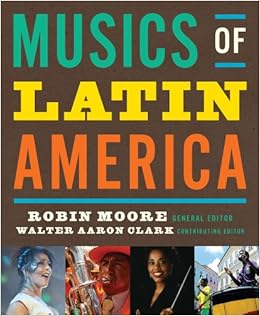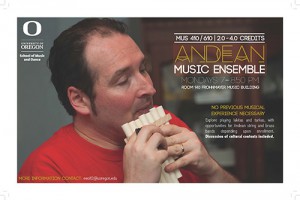MUS 359: Music of the Americas
TR 12:00-1:20 PM + Discussion Section Room: CLS 250

The Americas is a broad geographic expanse covering a range of cultures that is impossible to cover in-depth in a single academic term. There are ideas, however, that can help us bring important aspects of these cultures together: indigeneity, colonization, diaspora, and hybridity. Using these ideas, we will look at a number of countries and cultures in the Americas to see these ideas help us analyze music in specific regions. No musical experience is necessary, but students will be asked to think through listening examples to understand why different musics sound the way they do. This version of the class will focus primarily on countries in Latin America and the Caribbean, but the ideas are applicable throughout the Americas.
Selected Texts Include:
Moore, Robin with Walter Aaron Clark (eds). 2012. Musics of Latin America. W.W. Norton & Company: New York.
You will also need an i-clicker for this class.
M 7:00-8:50 AM Room: Frohnmayer Music Building 140
 One intellectual current within ethnomusicology is the idea of bi-musicality, or the ability to be fluent in more than one musical system. This course emphasizes the practice of music-dance from a specific region/culture and asks students to reflect on how this practice may compare with the musical systems they already have experience with. Students will be asked to take an embodied approach in learning. At the end of the term, students will share what they have learned with others through an end-of-term presentation. Students taking the class for additional credit (beyond 2.0 credits) are required to do additional work such as write an end-of-term research paper or produce a creative project related to region in question.
One intellectual current within ethnomusicology is the idea of bi-musicality, or the ability to be fluent in more than one musical system. This course emphasizes the practice of music-dance from a specific region/culture and asks students to reflect on how this practice may compare with the musical systems they already have experience with. Students will be asked to take an embodied approach in learning. At the end of the term, students will share what they have learned with others through an end-of-term presentation. Students taking the class for additional credit (beyond 2.0 credits) are required to do additional work such as write an end-of-term research paper or produce a creative project related to region in question.
This term is dedicated to learning about the music-dance traditions of the South Central Andes, a region in which I have spent time doing field work. Several of these traditions use instruments that are relatively easily learned (lakitas and tarkas), and everyone will learn a tune in these ensembles. It may be possible to explore two other traditions, the Andean string orchestra (guitars/mandolin/flute/violin/charango) and the Andean brass band (trumpet/baritone/tuba/clarinet/ sax/trombone), depending upon what skills students bring with them to the class. All students will be expected to sing and perform basic dance steps. No prior musical experience necessary.
Here’s an example of what students will be learning. The Spring 2015 class performing “Mighty Oregon” as an Andean march on lakitas.
Selected Texts Include:
Turino, Thomas. 2008. Music in the Andes. Oxford University Press: New York.
Instruments will be loaned for class as needed.